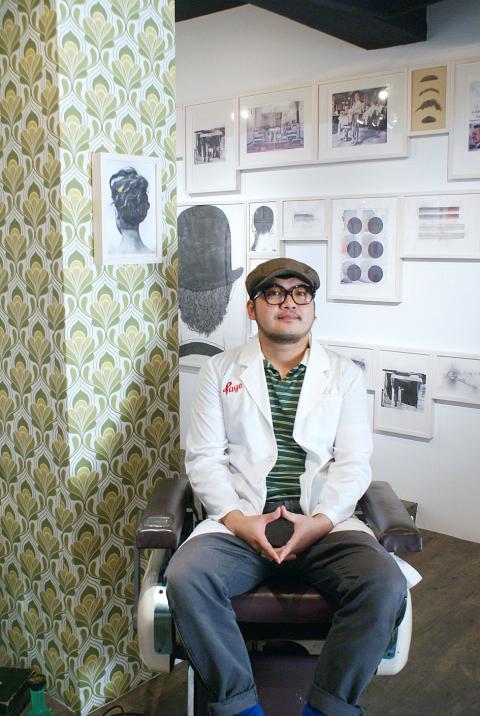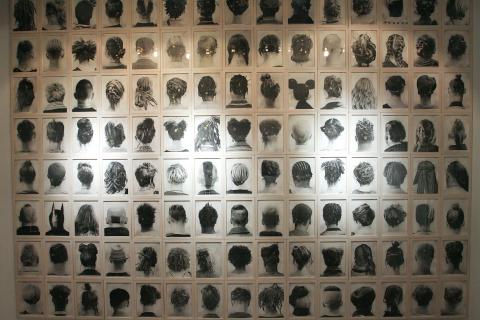Page Tsou’s (鄒駿昇) series of peculiar portraits in The And, Never End — (在視而不見的背後,本質,就在那裡), which is currently on display at the recently opened Agora Art Project x Space (藝譔堂), reverses the traditional form of portraiture by depicting the back of the subjects’ heads.
The face lends portraiture much of its power and demands that the viewer (often superficially) interpret the emotional and physical nuances of the visage he or she is looking at. Depicting the back of the head shifts the emphasis from the subject, freeing it from the constraints of the portrait form. This makes Tsou’s work exceptional.
The articulate, assured winner of several awards and accolades (he has drawn for the popular Swiss author Alain de Botton and the respected artist Quentin Blake, under whom Tsou studied at London’s Royal College of Art), explains the circuitous route that led to the works on display: “At first, I sketched from memory. After a thousand faces, though, I realized that memory has limitations. I couldn’t imagine anymore. At that point I sketched from real life. After 3,000 faces, it suddenly struck me: I’ve been drawing for 20 years and never bothered to focus on the back of the head,” said the artist.

Photo: Noah Buchan, Taipei Times
Tsou’s series is as much about a different way of looking at portraits as it is about how they are presented to viewers. Portraiture typically focuses the eye on one frame — an individual (or small group). The vertical and horizontal arrangement of the 120 medium-sized photos in 120 People in London, hung closely together, prompts a constant shifting of focus. Once accustomed to viewing the overall surface of the photos, however, it becomes apparent that Tsou’s work is about patterns, forms and textures.
Tsou’s pictures could be viewed like a picture of a mountain range — with its peaks and gullies, shadows and light — free from the kinds of psychological interpretations that we might apply to them because that’s what the portrait medium typically demands. These portraits are purely aesthetic.
Tsou emphasizes the landscape of the human head in a number of ways. He blanks out the background with a large white canvas (drawing the viewer’s attention to the head only). The viewer is incapable of determining where the photos were taken, or when. (The black-and-white pictures are reminiscent of daguerreotype photography of the 19th century.)

Photo Courtesy of Agora Art Project X Space
We can speculate — using the subjects’ tattoos, ear piercings and hairstyles, as well as their ethnicity and the title of the piece — that this is multicultural East London. But it could also be Johannesburg. Or Los Angeles. Regardless, this is not the point. Tsou’s pictures are not some psychological, sociological, political or trendsetting portrait of a person or place. They are random assemblages of human forms. Applying an underlying meaning to them is futile.
The above holds true for The And, a series of 27 images shot in a barbershop. Here, photography is partially erased and then replaced by illustration. Tsou says that the medium isn’t important. He’s created portraits using photography, illustration and video and says that it is how we look at the pictures and what they reveal about our own ways of seeing that matters.
Tsou’s images remind us that there is more to portraiture than the psychological disposition of its subjects. With this in mind, when we return to more traditional examples of portraiture, we are better equipped to appreciate their aesthetic beauty.

That US assistance was a model for Taiwan’s spectacular development success was early recognized by policymakers and analysts. In a report to the US Congress for the fiscal year 1962, former President John F. Kennedy noted Taiwan’s “rapid economic growth,” was “producing a substantial net gain in living.” Kennedy had a stake in Taiwan’s achievements and the US’ official development assistance (ODA) in general: In September 1961, his entreaty to make the 1960s a “decade of development,” and an accompanying proposal for dedicated legislation to this end, had been formalized by congressional passage of the Foreign Assistance Act. Two

Despite the intense sunshine, we were hardly breaking a sweat as we cruised along the flat, dedicated bike lane, well protected from the heat by a canopy of trees. The electric assist on the bikes likely made a difference, too. Far removed from the bustle and noise of the Taichung traffic, we admired the serene rural scenery, making our way over rivers, alongside rice paddies and through pear orchards. Our route for the day covered two bike paths that connect in Fengyuan District (豐原) and are best done together. The Hou-Feng Bike Path (后豐鐵馬道) runs southward from Houli District (后里) while the

March 31 to April 6 On May 13, 1950, National Taiwan University Hospital otolaryngologist Su You-peng (蘇友鵬) was summoned to the director’s office. He thought someone had complained about him practicing the violin at night, but when he entered the room, he knew something was terribly wrong. He saw several burly men who appeared to be government secret agents, and three other resident doctors: internist Hsu Chiang (許強), dermatologist Hu Pao-chen (胡寶珍) and ophthalmologist Hu Hsin-lin (胡鑫麟). They were handcuffed, herded onto two jeeps and taken to the Secrecy Bureau (保密局) for questioning. Su was still in his doctor’s robes at

Mirror mirror on the wall, what’s the fairest Disney live-action remake of them all? Wait, mirror. Hold on a second. Maybe choosing from the likes of Alice in Wonderland (2010), Mulan (2020) and The Lion King (2019) isn’t such a good idea. Mirror, on second thought, what’s on Netflix? Even the most devoted fans would have to acknowledge that these have not been the most illustrious illustrations of Disney magic. At their best (Pete’s Dragon? Cinderella?) they breathe life into old classics that could use a little updating. At their worst, well, blue Will Smith. Given the rapacious rate of remakes in modern